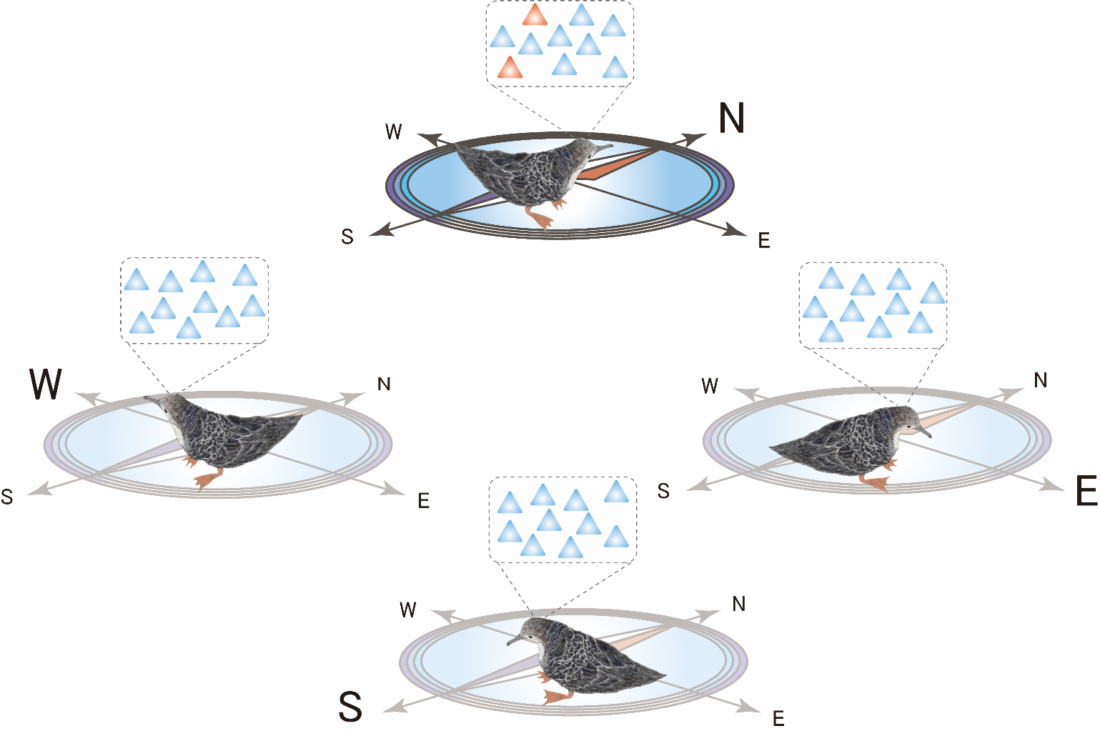Research News: Following the Inner Compass: How Birds Find their Ways to Foreign Lands
February 22, 2022
Head direction cells in the brains of streaked shearwater chicks might act like internal compasses to help the birds navigate during their initial migratory flight
Even in the absence of any landmark, migratory birds find their way to the far placed destinations. One theory says they follow the geomagnetic fields of the earth. But how do they do so? In a new study, researchers from Japan answer this question by examining the neurophysiological activities of head direction cells in the brain of a migratory seabird called the streaked shearwater. The findings will likely aid ecological conservation by correctly understanding the physiological mechanism of migration.
How migratory animals find their way to the wintering grounds, thousands of kilometers apart from their breeding ground, is a fascinating riddle of nature. Previous studies have suggested they possibly follow the geomagnetic field lines and olfactory cues to determine the direction. However, the physiological mechanisms behind this magnetic orientation remain unknown. Now, neuroscientists and ecologists from Doshisha University and Nagoya University, Japan, conducted a study to understand how birds know which direction to follow during long-distance flight. The study has been published on Feb 4, 2022, in the latest issue of the journal Science Advances.
To date, studies show that migratory birds navigate through new terrains or over oceans sans any landmarks by perceiving the geomagnetic fields of the earth. They do this with the help of the magnetically sensitive proteins in their eyes and the magneto-receptive cells in the vestibular nucleus in their brain. The vestibular nucleus is also known to contribute to the activity of the head direction (HD) cells involved in this directional sensing. This link prompted Professor Susumu Takahashi of Doshisha University, the lead and corresponding author of the study, and his colleagues (including Professor Ken Yoda from Nagoya University) to hypothesize that the directional and the magnetoreception senses may share a few common neural players.
The team decided to explore how the brain combines the magnetoreception and direction senses by studying the activity of HD cells of the streaked shearwaterー a species of seabirds that breed on islands in Japan, Korea, and China and eventually migrate to wintering grounds located in the Philippines, Indonesia, and northern Australia.
“Interestingly, during their first migratory flight, juvenile birds do not follow the easier detours along the coastline taken by their parents. Instead, they fly directly towards the destination through difficult mountain ranges. This suggests that the juvenile birds rely heavily on the orientation of their in-built compass, rather than the environmental cues followed by the adult ones,” Prof. Takahashi shares.
To do this, they took the help of a lightweight device called a “neurologger”, that can wirelessly record the electrophysiological activity of the brain of freely behaving wild animals. First, they captured five male and five female streaked shearwater chicks from their burrows and housed them in the light-shielding cages. Then, they used the neurologger to record the electrophysiological activity from the medial pallium region of the brain. Next, they let the baby birds walk freely and repeatedly in two environments—in a room and on a sea-facing cliff—2.5 km and 1 km far from their burrows, respectively. While the ceiling lights, desks, and chairs in the room served as visual cues, the sun’s direction was not perceivable to the birds.
The researchers found that around 20% of the cells in the medial pallium region fired electrical pulses with higher frequency when the birds faced towards a specific orientation. The preferred orientation was distributed unevenly in the northern direction. But, when the birds faced orientations other than the north, the cells remained less active. This preference for the north was observed even when the experimental location was moved more than a few kilometers, suggesting the location-independent geomagnetic field was used as a cue for head orientation.
The study underscores the role of the HD cells as internal compasses that preferentially represent north orientation at the onset of the first long flight of the migratory birds. Also, the HD cells aid in the integration of the direction and magnetoreception senses. Professor Takahashi is hopeful that the newly gained insights into the neuronal role in navigation mechanisms of migratory birds would open newer avenues in ecological conservation research.
“Our findings suggest that the avian internal compass can be utilized to gain insights into the neuronal underpinning of animal migration patterns. It will potentially contribute to the fulfilment of the United Nations’ Sustainable Development Goal #14: Life Below Water,” he concludes.

Diagram showing the head direction cells of a Streaked Shearwater chick preferring the north like an internal compass.
Roughly 20% of cells in the brain (medial pallium; red triangles) increase their firing rates when the chick faces the north, while they (blue triangles) are less active when it faces other orientations (east, west, south, etc.) as shown on the left, right, and bottom. Neurons are represented by triangles, with high activity represented by red and low activity represented by blue.
Image courtesy: Hiroaki Kitagishi from Doshisha University
Reference
| Title of original paper | Head direction cells in a migratory bird prefer north |
| Journal | Science Advances |
| DOI | 10.1126/sciadv.abl6848 |
| Latest Article Publication Date | 4th February 2022 |
| Method of Research | Experimental study |
| Subject of Research | Animals |
| Conflict of Interest Statement | The authors declare that they have no competing interests. |
Funding information
This study was supported by Japanese Society for the Promotion of Science Kakenhi grants 16H06543, 19H01131, and 21H05296
Profile

Dr. Susumu Takahashi is a Professor at the faculty of the Graduate School of Brain Science, Doshisha University, Japan. His Laboratory of Cognitive and Behavioral Neuroscience focuses on research questions related to neural substrates of episodic memory encoding and retrieval, neuronal mechanisms underlying spatial navigation, and migratory birds, among others. Prof. Takahashi is a member of the Society for Neuroscience. He has published more than 40 research papers in reputed journals.
Susumu Takahashi
Professor, Faculty of the Graduate School of Brain Science
Media contact
Organization for Research Initiatives & Development
Doshisha University
Kyotanabe, Kyoto 610-0394, JAPAN
CONTACT US
